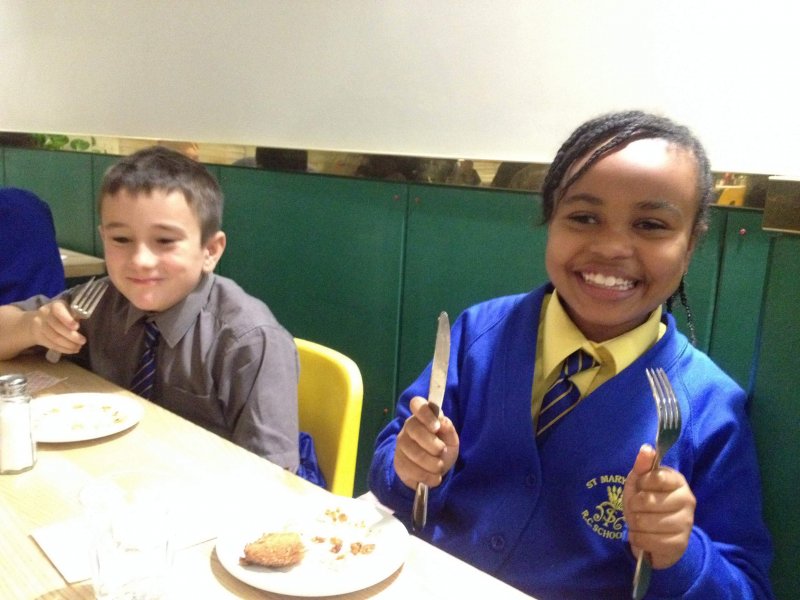
“I’d give it an 11 out of ten,” eight-year-old Fenet tells me, looking thoughtfully at the piece of chicken at the end of her fork. The other children at the table nod in agreement.
We’re sitting on bright yellow school chairs in a converted fire station in Tottenham, north London. On first glance, Chicken Town is a standard family-friendly restaurant similar to other fast-but-good food chains such as Nando’s or Byron. However, it is also not for profit and uses its evening service to subsidise cheap, healthy food for children during the day.
Chicken shops have a confusing reputation. In some parts of London, nearly a quarter of 11-year-olds are obese and chicken shop meals dripping with fat and high calories aren’t helping. Sadiq Khan, Labour’s London mayoral candidate, said at this summer’s hustings that there are “too many” fried chicken outlets, especially near schools. Yet, as he also pointed out at a celebration of a large Chicken Cottage in his constituency, they are also a symbol of communities where coffee chains and bourgeois bars haven’t yet penetrated. For parents, they offer a cheap, filling dinner which kids enjoy.
This is where Chicken Town comes in. The restaurant’s director, Ben Rymer, working with Hadrian Garrard, director of creative arts charity Create, hopes to keep the typical chicken shops’ sense of community while cutting back on the calories. For more than a year, his team have worked to perfect the £2 “junior special”, consisting of two pieces of chicken and two sides. When I visited, kids were given chicken, coleslaw (made with carrot, apple and a mix of mayonnaise and yoghurt) and sweet potato fries.

Two local children enjoy their meal. Image: Author’s own.
The birds are free range and herb-fed in Yorkshire. This upbringing, Rymer tells me, gives them a “totally different” body shape: “the thighs are massive because they’ve been running around, and the legs are a lot skinner”. It also gives them enough flavour to survive the healthier cooking method. The restaurant’s chefs remove the skin, steam the meat and then “flash fry” it in crispy panko bread crumbs and rapeseed oil for four minutes.
The recipe sold in the junior special was formulated with the help of the chef Giorgio Ravelli, once of the Ledbury, and the attention to detail has paid off: the chicken in the Junior Special has an eighth of the salt of high street chicken and a quarter of the saturated fats.
I try a piece of smoked chilli chicken sold on the evening menu, and am impressed by the flavour of the smoked meat and slightly sweet, crisp outer skin. Most importantly, though, children visiting from a local estate to test the special all clear their plates. “I love the chicken! They called it Chicken Town for a reason,” the nine-year-old James tells me as I leave.

Chicken being prepared for the evening service.
“It’s not about cutting things out,” Rymer tells me. “You can’t just ban things. As the war on drugs showed, that doesn’t work. My thing has always been about giving people choice.”
The Greater London Authority (GLA) provided Chicken Town with a substantial chunk of its funding and is hopeful that it could be a proof of concept for similar projects.But any project in another area would need to be specific to that community: Chicken Town’s secret is that it identified a food people in the area loved, then worked to make it healthier.
Everything at Chicken Town has been tailored to purpose, from the meat (which isn’t halal, as organic, herb fed halal meat is hard to come by, and the proportion of Muslims in the area is low) to the simultaneously school-like and fashionable interior, designed by Turner Prize-winning architecture collective Assemble. The two types of service are clearly defined: sitting with the kids, I feel I could easily be in a school cafeteria, but Garrard tells me that at 6:30, “the lights go down and the candles come out” for dinner.

The restaurant’s Assemble-designed interior.
Whatever the project, though, Rosie Boycott, the GLA’s chair of the London Food Board, tells me that the £2 price is crucial to challenging fast food outlets: “You don’t want it to be so expensive it becomes cool, upmarket food for the middle classes. Chicken shops are phenomenally cheap. If you start charging £4, you’ve lost the battle.”
If Chicken Town is a success, it could provide a working model for other schemes to challenge the fast food outlets on their own turf. As Boycott tells me, “It’s about finding something that’s incredibly familiar, where people feel comfortable, and saying you can have all of that joy, with none of the downsides.”
Unmarked images: Chicken Town.





